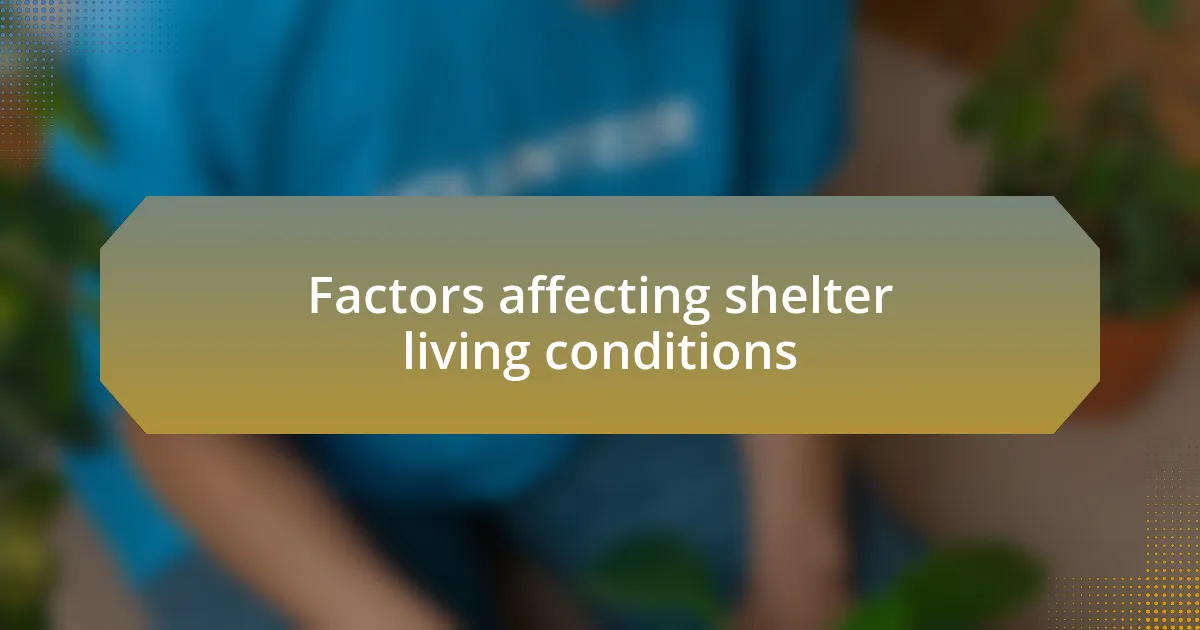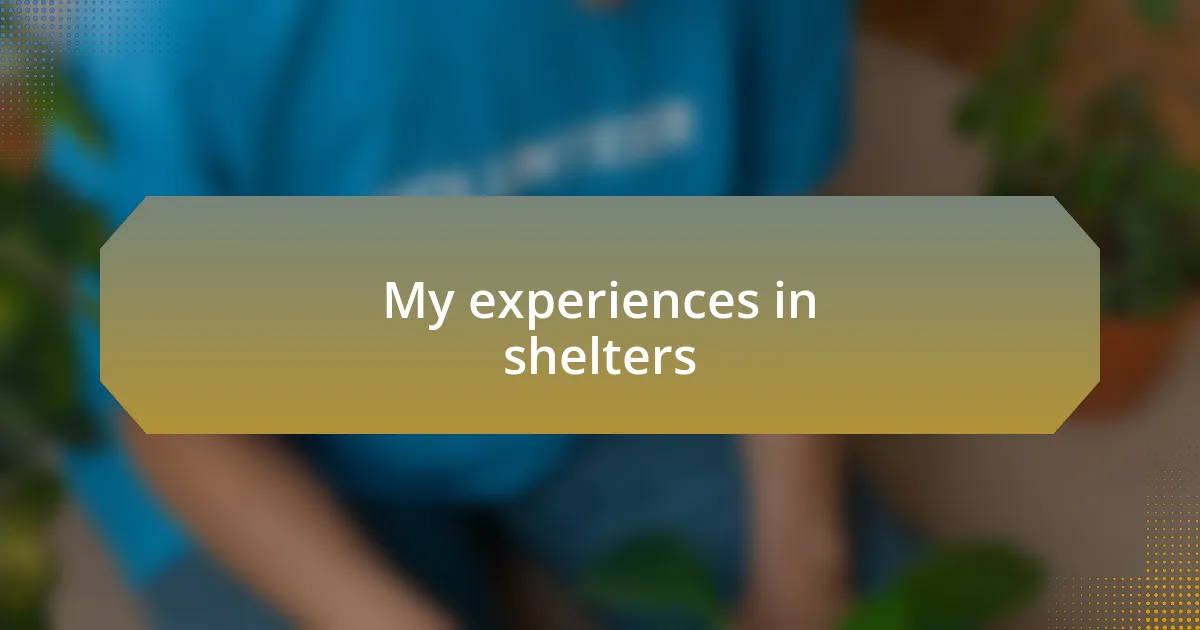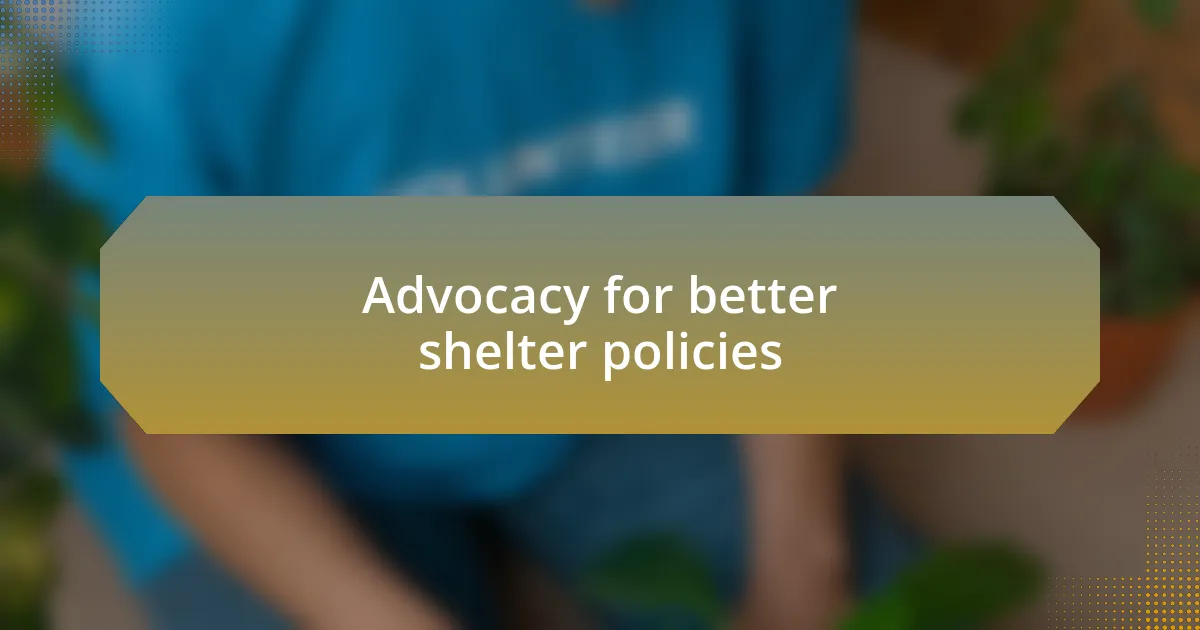Key takeaways:
- Homelessness is a complex issue affecting both individuals and communities, often accompanied by emotional and mental health challenges.
- Homelessness charities play a crucial role in providing essential services, advocating for systemic change, and fostering community connections.
- Living conditions in shelters vary significantly based on funding, resources, and staff dedication, impacting residents’ overall well-being.
- Advocacy for better shelter policies must incorporate the perspectives of individuals experiencing homelessness to create effective solutions and ensure safe environments.

Understanding homelessness issues
Understanding homelessness issues is a multifaceted endeavor that requires us to look beyond the surface. What often strikes me is how stigmatized those experiencing homelessness can feel—like they’re invisible. I once met a man named Tom who shared stories about his life before losing his job. Hearing him describe how his circumstances spiraled downward made me realize how easily anyone can find themselves in a similar situation.
The complexities surrounding homelessness impact not just the individuals but the entire community. Sometimes I wonder, how do we quantify the emotional toll? People living on the streets face not only physical hardships but also mental health challenges that often go unnoticed. I remember speaking to a woman who had been in and out of shelters, and her struggle with anxiety was palpable. It opened my eyes to the fact that when we think of homelessness, we must also consider the profound emotional scars that accompany these experiences.
Additionally, the lack of stable housing can create a cycle that’s incredibly difficult to break. I’ve spoken with individuals who spent years attempting to secure permanent housing, only to be thwarted by the high cost of living and limited support services. It begs the question: how do we, as a society, create more effective systems to lift people out of this cycle? The journey toward understanding homelessness is not just about identifying issues; it’s about recognizing the humanity and potential of every individual involved.

Importance of homelessness charities
In my view, homelessness charities serve as a vital lifeline for those in need. I recall volunteering at a local shelter, where I witnessed the incredible impact of these organizations firsthand. They don’t just offer temporary housing; they provide essential services like job training and mental health support that empower individuals to rebuild their lives. Isn’t it uplifting to think that a simple act of kindness can lead to significant life changes?
Moreover, these charities often act as advocates for systemic change, bringing attention to the policies that perpetuate homelessness. From my experience, I’ve seen how they rally communities around common goals, working tirelessly to change perceptions and raise awareness. I often ask myself, what would happen without these advocates? They play a crucial role in pushing for legislation that supports affordable housing and mental health services, highlighting that the fight against homelessness is a collaborative effort.
It’s also important to recognize that charities foster a sense of community and belonging for those who may feel isolated. One evening at the shelter, I chatted with a father and his daughter who found companionship and support in their shared experience. I was struck by how these interactions not only address immediate needs but also cultivate relationships that help break down the isolation of homelessness. How can we expect individuals to thrive without connection? This is a poignant reminder that, at the core, it’s about creating a nurturing environment where everyone feels valued and supported.

Types of homeless shelters
When considering the types of homeless shelters, I often think about the various models that cater to different needs. For instance, emergency shelters usually provide immediate refuge, ensuring safety for people facing crisis situations. I remember visiting one that opened its doors at night, a crucial service that offered warmth to those who might otherwise sleep outside in the biting cold.
On the other hand, transitional housing operates as a bridge, allowing individuals and families to stay for longer periods while they stabilize their lives. I encountered a mother who had secured a place in a transitional shelter, sharing how it afforded her the time to find a job and save for a permanent home. Isn’t it inspiring how a little stability can lead to renewed hope?
Finally, there are specialized shelters targeting specific populations, such as veterans or families, which provide tailored support and resources. This approach makes such a difference. I once met a veteran in a shelter designed just for him, attending workshops that equipped him with skills for a successful reintegration into society. Seeing how much more at ease he felt there reinforced my belief: everyone deserves a space that understands their unique journey.

Factors affecting shelter living conditions
The living conditions in shelters can vary significantly based on funding and resources available. One evening, I visited a shelter that had seen better days—peeling paint and overcrowding made the environment feel cramped and uncertain. It struck me then how crucial adequate funding is; without it, many shelters struggle to maintain clean, safe, and welcoming spaces.
In my experience, the staff’s dedication plays a pivotal role in how residents perceive their living conditions. I recall speaking with a case manager who went above and beyond to connect people with services, creating a sense of community that uplifted everyone. When residents feel supported and valued, doesn’t it naturally lead to better overall well-being?
Another factor is the location of the shelter. A facility situated in a well-connected area can offer residents easier access to job opportunities, education, and healthcare. I remember hearing from someone who had to walk miles to reach essential services from their shelter, highlighting how crucial it is for shelters to be strategically located. If a shelter is isolated, how can it truly serve its purpose?

My experiences in shelters
When I first walked into a shelter, I was struck by the diverse stories surrounding me. Each person had their own journey, and the atmosphere was a mix of hope and despair. I remember sitting down with a young man who shared his dreams of getting back on his feet. Listening to him was a reminder that shelter living is often more than just a roof over one’s head; it’s about building connections and finding a path forward.
I’ve seen how small acts of kindness can change the dynamic. Once, while volunteering, I noticed how a simple game night brought laughter and camaraderie among residents. It was amazing to witness how something as simple as playing cards could foster a sense of belonging. Could a supportive community make all the difference? I believe it can.
Yet, not every experience was positive. I recall a night spent in a shelter overflowing with people—the noise and chaos felt overwhelming. I would often find myself wondering how many others shared the same unsettling feelings. In that moment, I realized that while shelters provide essential services, the mental and emotional landscape can be just as important for recovery and stability.

Suggestions for improving conditions
To improve conditions in shelters, focus on creating designated quiet areas. I remember a particularly hectic evening when I desperately needed a moment to collect my thoughts. Having a space specifically for relaxation could transform the experience for many individuals, offering a refuge from the overwhelming atmosphere that can sometimes reign.
Moreover, implementing a structured plan for daily routines would provide much-needed stability. In my observations, when shelters offered scheduled activities—such as meal times or workshops—people felt more engaged and a sense of purpose emerged. Isn’t it powerful how routine can foster a sense of normalcy, even in challenging circumstances?
Lastly, I think increasing staff training around mental health support could significantly enhance services. When I witnessed a staff member taking the time to listen to someone in distress, it highlighted the profound impact that understanding and empathy can have. Could trained personnel equipped with emotional support skills create an environment where individuals feel valued and understood? I’m convinced the answer is yes, and investing in this area could lead to more positive experiences for everyone involved.

Advocacy for better shelter policies
Advocacy for better shelter policies should prioritize the voices of those who experience homelessness firsthand. I vividly recall discussions with individuals in shelters who expressed a desire for more say in how policies are developed. How can we expect to create effective solutions without consulting the very people they affect? Listening to their concerns isn’t just a box to check; it’s essential for genuine progress.
In addition, ensuring that shelters adhere to standards of safety and cleanliness is vital, yet often overlooked. I once spent a night in a shelter that had inadequate sanitation facilities, which left me feeling uneasy and anxious. Should anyone have to endure such conditions when seeking refuge? Establishing clear guidelines and regular inspections can help ensure that shelters not only provide a roof over one’s head but also a safe and welcoming environment.
Furthermore, advocating for partnerships with local businesses to provide job training and placement opportunities can empower individuals to rebuild their lives. During my volunteer days, I witnessed the transformative effect of skills training programs. Wouldn’t it be inspiring to see more shelters collaborate with community organizations to foster hope and independence? Investing in these programs could create a path forward, helping people regain their sense of purpose and community integration.